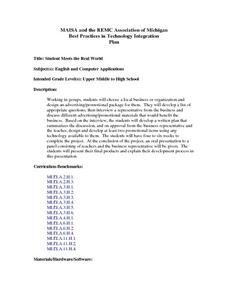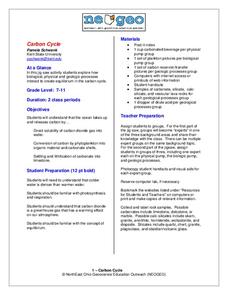Curated OER
Student Meets the Real World
Students interview a local business person in order to design an advertising or promotional for their business. They summarize the meeting and use the information to design two promotional items using available technology. They make a...
Curated OER
Customary Capacity
Third graders convert customary units of capacity to make a gallon man out of construction paper. They use the computer to make a tree map of gallons, quarts, pints, and cups to show these conversions.
Curated OER
You Belong in the Zoo Project - Using HyperStudio
Students explore the diversity of living organisms. They research an animal found in the zoo and plans a 10-card HyperStudio project about his/her organism.
Curated OER
What Can Scatterplots Tell Us?
Eighth graders use data from surveys conducted with parents, peers and themselves to create computer-generated scatterplots. They make inferences from their scatterplots.
Curated OER
Tour of Our Century
Students will research the politics, arts, social climate, technological and
scientific advances of the 1900s. They will work in cooperative groups to
identify the most significant advances of one decade then use a computer to create a...
Curated OER
Go for the Gold!
The options are vast with this Ancient Greece and Olympics research project! Using Scholastic online resources, historians have interactive and educational supports to guide them through researching and writing about the 2004 Olympics in...
PBS
Universal Declaration of Human Rights
What rights are guaranteed to students? Do they align with the Universal Declaration of Human Rights, which was approved by the United Nations in 1948? Middle and high schoolers present persuasive arguments about the rights they believe...
NorthEast Ohio Geoscience Education Outreach
Carbon Cycle
Using a jigsaw approach, earth science experts teach each other about the physical, biological, and geologic components of the carbon cycle, with a specific focus on the ocean.
Curated OER
Archimedes' Principle of buoyancy
Students use the internet to research Archimedes' principle of buoyancy. In groups, they summarize the principle and share it with the class. They also participate in experiments in which they test the principle and share their results...
Curated OER
Study of Animals
Third graders use the internet to research about an animal. After watching a demonstration, they follow the same steps to gain access to the internet as their teacher and find a picture of their animal to print. They complete a worksheet...
Curated OER
Newtonian Mechanics
Students familiarize themselves, through teacher demonstration, with Gavendish's apparatus first used for experimentally determining the value of the Universal Gravitational Constant G, and calculate theoretical value of Earth's...
Pace University
Community Helpers
Differentiate instruction with a unit focused on community helpers. A pre-assessment levels scholars into three groups. Learning contracts offer participants the choice of activities to complete and show what they know about specific...
Curated OER
Global Diversity Through Literature
Students investigate Southwest Indian Reservations. In this Native American activity, students research Southwest Indian tribes on the Internet and by reading the book, Arrow to the Sun.
Curated OER
Indegenous Cultures Magazine in Publisher
Fourth graders use Publisher to create their own magazine. In this online magazine lesson plan, 4th graders follow the instructions to create a magazine using text, pictures, and colors within the Publisher system.
Curated OER
Website Design Using HTML Code
Students participate in an activity to discover vocabulary necessary for website design. They observe a demonstration of website design using HTML code and then design two simple web pages with specific criteria. The final project allows...
Curated OER
Variable Arrays
Twelfth graders compare and contrast variables and arrays. Using data, they enter the information into a spreadsheet and an array to compare how they appear. To end the lesson, they complete basic programs in which they use arrays.

















